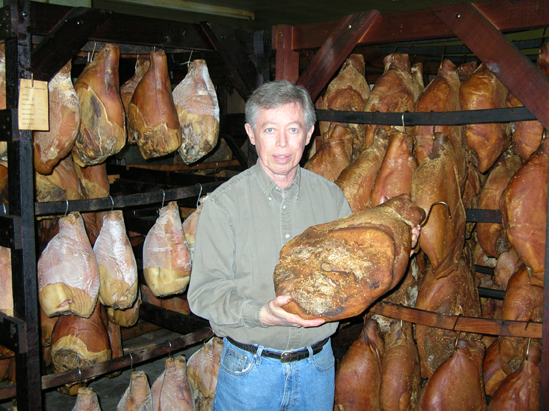Meats and Sausages
American Country Ham
Only the hind legs of hogs can be called a country ham. They may not be injected with curing solutions nor placed in curing solution. The application of salt shall be a sufficient quantity to insure that the finished product has an internal salt content of at least 4 percent. For hams or pork shoulders labeled “country” or “country style,” the combined period for curing and salt equalization shall not be less than 45 days for hams, and shall not be less than 25 days for pork shoulders; the total time for curing salt equalization, and drying shall not be less than 70 days for hams, and shall not be less than 50 days for pork shoulders. During the drying and smoking period, the internal temperature of the product must not exceed 95 °F, provided that such a temperature requirement shall not apply to products dried or smoked under natural climatic conditions.
Ham manufacturing process:
- Salting. Salt and nitrite/nitrate are rubbed in all over meat and skin. Care should be taken to pack the salt deep into the exposed bone areas. The ham remains covered in salt for at least 30 days at 36-40° F (2-4° C). More curing solution is applied during that time. Any accumulated liquid is drained away. Then the hams are washed and the surface is brushed off to eliminate any crystalized salt. Such salt clogs the meat pores and will prevent proper drying or smoking.
- Equalizing. Spices and sugar may be rubbed in. Hams are placed in cloth or net bags. In the past a wire was threaded through a hole cut in the hock. Occasionally, the hams were not hung but lied on a side on the shelves. This 2 weeks equalization period (3 days per pound) allows for more even salt distribution inside. The temperature varies from 50 - 54° F (10-12° C), 75% humidity.
- Smoking. Hams are cold smoked for 24-30 hours.
- Drying/Maturing. Hams lose more moisture and develop a characteristic flavor. This is also known as the ripening stage and it continues for 30-90 days. Temperature varies from 77-86° F (25-30° C), 65% humidity.
The production of American country hams is concentrated in the Eastern states such as Virginia or Tennessee. There are many local processors that produce excellent country hams, for example Benton’s Smoky Mountain Country Hams in Madisonville, TN.
I made a decision early on in my country ham business that I would try to not make more hams; I would try to make better hams.
Mr. Benton has been involved with making hams since his childhood when he helped his family with pig slaughter and meat processing every year in early December in the Smoky Mountains. Since 1973 he runs a USDA approved and inspected country ham producing business. The hams are rubbed with ⅔ rd of a dry mix consisting of salt, brown sugar, and nitrite. Then they are left on maple shelves for 1 week at 38-40° F (3-4° C). After that, in about a week the remaining ⅓ rd of the cure is applied and the hams are restacked. They typically stay in that first stage of cure at thirty-eight to forty degrees for about two months - somewhere in the fifty-five to sixty day range. Then the hams are hung for 6 weeks in an equalization cooler at 42-50° F (6-10° C). From there they go into a smokehouse where they would hang until they are used up in the next fall. The average country ham that is made there is about nine months old.

Allan Benton and his hams.
Photo courtesy Benton’s Smoky Mountain Country Hams
www.bentonshams.com













